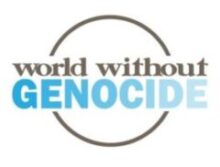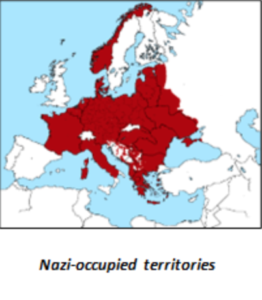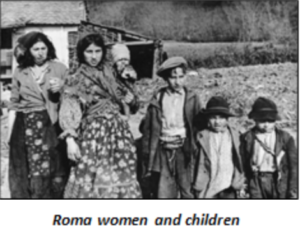The Genocide of the Roma
What
The ‘Porajmos,’ which translates to ‘the devouring,’ is the term used by the Roma to describe the Holocaust. During World War II, Roma people across Nazi-occupied Europe were subjected to a systematic campaign of genocide. Today, the Holocaust of the Jewish people is widely commemorated, yet the plight of the Roma is much less discussed.
The Roma, also called Travelers and derogatorily called ‘Gypsies,’ are a nomadic people with origins in northern India. They are traditionally craftspeople and performers. Roma have faced centuries of discrimination in Europe based on ethnicity, stereotypes of criminality, and poverty.
When
After Hitler’s rise to power in Germany in 1933, the Nazi regime used propaganda to amplify existing negative stereotypes of the Roma. They categorized Roma as ‘subhuman’ and ‘unworthy of life.’ During the mid-1930s, the Nazis banned Roma from certain jobs, subjected them to forced sterilization, and forbade inter-marriage between Roma and other Germans.
Before 1939, between 1 and 1.5 million Roma lived in Europe. Nazi idealogues saw this as a ‘plague’ on Aryan society. In 1942, the Third Reich officially launched a campaign to exterminate the Roma, which continued until the end of World War II in 1945.
How
Nazi officers imprisoned, deported, and sent thousands of Roma to concentration camps. Many were murdered in gas chambers. At least 19,000 Roma were killed at the Auschwitz killing center alone. Others were murdered at random by the Einsatzgruppen, Hitler’s mobile killing squads. In total, roughly 500,000 Roma were killed between 1933 and 1945.
Response
After World War II, Roma in Europe struggled to gain recognition for their persecution. The genocide of the Roma was not prosecuted at the Nuremburg Trials, and international attention was largely focused on atrocities perpetrated against the Jewish community. Germany did not officially recognize the genocide of the Roma until 1982.
Today, 10-12 million Roma live in Europe, and about 1 million live in America. They often struggle to access vital services such as education, housing, and safe drinking water. Roma are subjected to widespread discrimination and violence, which rarely makes the news. They enjoy little support from international watch groups or governments. In 2015, the United Nations launched global efforts to address the situation of the Roma and to protect and enhance their human rights.
Updated 2021.
References
“Advancing Roma Inclusion.” https://www.ohchr.org/EN/Issues/Minorities/Pages/UnitedNationsRegionalWGonRoma.aspx
“Genocide of European Roma (Gypsies), 1939–1945.” https://encyclopedia.ushmm.org/content/en/article/genocide-of-european-roma-gypsies-1939-1945
“Genomic Study Traces Roma to Northern India.” https://www.nytimes.com/2012/12/11/science/genomic-study-traces-roma-to-northern-india.html
“Remnants of Concentration Camp Used to Imprison Roma Found in Czech Republic.” https://www.smithsonianmag.com/smart-news/czech-archaeologists-find-remains-concentration-camp-roma-180976294/
“Roma (Gypsies) in Prewar Europe.” https://encyclopedia.ushmm.org/content/en/article/roma-gypsies-in-prewar-europe
“Roma Holocaust remembrance has lessons for Europe today.” https://fra.europa.eu/en/news/2020/roma-holocaust-remembrance-has-lessons-europe-today
“Second European Union Minorities and Discrimination Survey: Roma – Selected findings.” https://fra.europa.eu/sites/default/files/fra_uploads/fra-2016-eu-minorities-survey-roma-selected-findings_en.pdf
“The Forgotten Holocaust and The Continued Persecution of the Romani.” https://worldwithoutgenocide.org/genocides-and-conflicts/holocaust/romanipersecution#_ftn1
“The Persecution of the Roma Is Often Left Out of the Holocaust Story. Victims’ Families Are Fighting to Change That.” https://time.com/5719540/roma-holocaust-remembrance/
“The Romani porajmos: The nazi genocide of Europe’s gypsies.” https://www.tandfonline.com/doi/pdf/10.1080/00905999108408209?casa_token=KZ-1OU2tB8EAAAAA:_IgOrjbVk9BK3fFdxCPPk8kYLrHseFr7h3KC0Lp310XquuTwy57mt0lpP8-J-Op_HzrlhvCDLA0
“Who are the Roma people?” https://www.euronews.com/2017/08/01/who-are-the-roma-people




